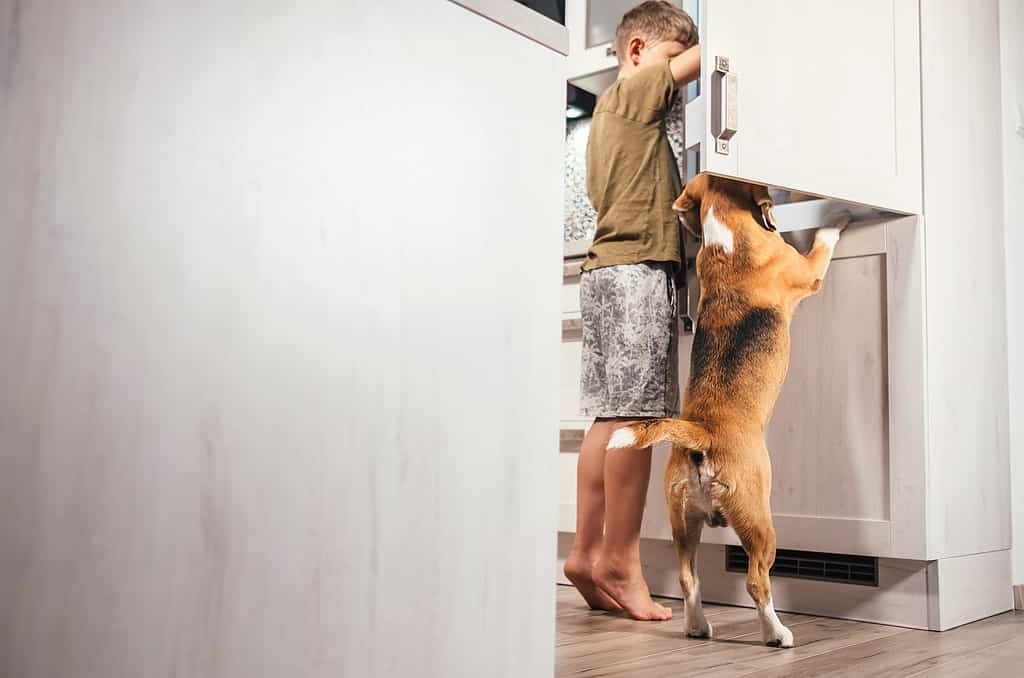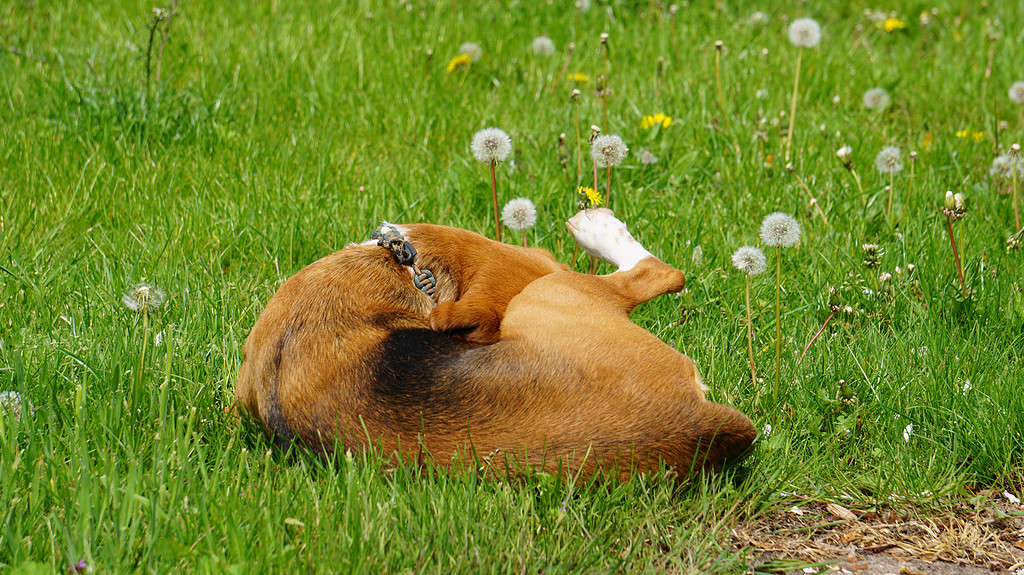Beagles are loving companions and great family dogs. They’re also one of the most popular dog breeds. If you own a beagle, you’ll never be bored again. They run around wherever you go, happy to be a part of the pack. However, they come with some quirks that can be frustrating if you’re unprepared. Below, we look at 13 common complaints to determine if beagles are the most troublesome dogs. We’ve also included ways to handle some of these common complaints to help you and your beagle come to a compromise.
Characteristics of Beagles

Beagles are one of the most popular dog breeds even though they come with some challenges.
©New Africa/Shutterstock.com
Beagles are considered one of the least intelligent dogs, but it’s not because they’re dumb. Beagles are very strong-willed. They only listen if the reward they get in exchange is worth it. But once you get past their tough-guy attitude, they are one of the most fun and loving breeds.
But are beagles the most troublesome dogs? Keep reading to find out why some people might think so and how to handle some of these complaints if you own a beagle or plan to own one.
13 Common Complaints About Beagles
1. Stubbornness

Beagles are one of the most troublesome dogs because of their stubbornness.
©oleghz/iStock via Getty Images
One of the most common complaints about beagles is their stubbornness. Dogs have an IQ equivalent to that of a two-year-old child. Beagles also have the temperament of a two-year-old. Training a beagle is not for the faint of heart. It requires a lot of time and patience. Often, beagles are stubborn because they’re unsure of what you want from them, are distracted, uncertain of who the pack’s leader is, or are anxious.
Training a beagle is just as much training yourself. The level of dedication to train a beagle isn’t possible for some people, and that’s okay. But the love a beagle brings into your life is worth the frustration of training. Working with their stubbornness rather than against it will help strengthen your bond.
2. Frequent Barking and Baying

You always remember the sound of the signature beagle bay once you hear it.
©LivingThroughTheLens/iStock via Getty Images
Frequent barking is one of the most common complaints about beagles and a top reason beagles are one of the most troublesome dogs. Sometimes, you’ll hear a beagle before you see them. They are one of the most vocal breeds. In fact, they make three distinct sounds. Beagles bark like most dogs, howl, and make a noise like a yodel called baying. Baying is a sharp and loud noise originally used while hunting. Not all beagles still hunt, but many bay when they spot another dog or want your attention.
3. Separation Anxiety

Having separation anxiety is one of the most common complaints about beagles.
©Tetiana Garkusha/iStock via Getty Images
Another reason beagles are considered one of the most troublesome dogs is their separation anxiety. Leaving your dog at home can be stressful as is. Add separation anxiety to the mix; it sometimes feels like you can never leave your house again. Beagles are pack dogs. They enjoy the company of others, whether it’s other dogs at home or their favorite humans.
Rescue beagles are especially susceptible to separation anxiety. As a result, they are one of the worst breeds for apartment living. They love running around, making them best suited for an active owner or a family with a backyard. Otherwise, their separation anxiety and frequent vocalizations can make leaving for work stressful for you and become a nuisance to your neighbors.
Separation anxiety manifests in various ways, including excessive barking, destructive behavior, accidents, and other anxious behaviors even when you return home. Working with a trainer or using vet and FDA-approved methods can help with separation anxiety, but it’s not a one-size-fits-all solution.
4. Prey Drive

Beagles have such a strong prey drive they sometimes lose their awareness.
©Andrii Zastrozhnov/iStock via Getty Images
Beagles are small to medium scent hounds bred for hunting rabbits. In fact, the type of hunting they are most known for is called “beagling.” They have more scent receptors than humans and other dog breeds, often getting them in trouble. That’s why they’re sometimes called “a nose on paws.” However, they know how to make walking around the neighborhood more exciting.
Although it’s in their nature, their strong prey drive can be dangerous. Beagles should always be on a leash outside an enclosed area because strong scents can cause their ears to stop working. Not literally, but it seems that way. An exciting smell can diminish their awareness and recall. It’s not uncommon for them to wander off and get lost, sometimes finding themself in unsafe situations. They may run into traffic or come face-to-face with large wild animals like bobcats, bears, or alligators.
5. Digging

Beagles follow their nose, even if it takes them underground.
©Tetiana Garkusha/iStock via Getty Images
Sometimes, a scent leads right into the ground. Beagles often dig in the yard for small animals that burrow underground. Depending on where you live, they might find a prairie dog or a rabbit hole they want to investigate. Or one of the neighborhood squirrels hid nuts in the grass, and your beagle is ready for their afternoon snack. They may also dig to get under the fence to chase something across the street. Otherwise, it may be too hot outside, and they want to cool down in the dirt.
6. Leash Pulling

Leash training is essential for beagle owners.
©Olena Kurashova/iStock via Getty Images
Sometimes walks feel more like a “sniffari” because they track scents wherever they go. This means you may spend most of your time outside standing by the same tree or zig-zagging through the neighborhood because they caught the scent of another dog out of sight. In this case, your beagle is walking you rather than the other way around. While allowing your dog to sniff around is mentally stimulating, it can be unsafe when they erratically pull you into the street or go after another person or dog.
There are many ways to leash train your beagle, so finding the best method for you is important. But always ensure they wear a collar and/or harness in addition to their leash if they’re not in an enclosed area to keep them safe. Their problems with authority are evident while on walks, adding another reason why beagles are considered one of the most troublesome dogs.
7. Food Obsessed

Beagles are food-driven, contributing to their risk of obesity.
©iStock.com/NeonShot
Obesity is a common health problem among beagles. They love to eat and are effective beggars. They even scarf down crumbs from the floor like it’s their last meal. As a result, it’s easy for them to get more than their fair share of food. You might also think twice about sneaking them a chip. Once they get a taste, they will come running whenever they hear the bag open.
Sticking to a diet and exercise routine that works for their body type will keep them at the right weight. Beagles with food allergies or thyroid problems should get vet-approved food to manage their conditions better.
8. Sneaky

Beagles are known to steal unattended food and small items, which can cause them to get sick.
©Solovyova/iStock via Getty Images
Don’t leave your TV remote, scrunchies, or food unattended, or they will be the new possessions of your four-legged friend. In addition to eating any food they find, they are also expert thieves. If they are left alone for too long, you may notice one of these items in ruins on the floor. Dogs aren’t spiteful creatures but know how to get the attention they crave. Bored beagles are one of the most troublesome dogs.
Limit the number of chewable objects in reach of your beagle; otherwise, you risk an intestinal blockage. Even well-trained beagles can have a moment of weakness and tear apart your shoe while you make a phone call. They are also great escape artists. Once they learn to open doors or get onto the table, they will do it as often as they want. But it’s hard to stay mad when they have such sweet faces.
9. Resource Guarding and Possessiveness

Some beagles resource guard their food, toys, and other household items they consider valuable.
©alex_ugalek/iStock via Getty Images
Resource guarding and possessiveness are attributed to several factors, including abuse, insecurity, and resource competition in previous environments. They do this to protect what is valuable, such as food, toys, and people. These behaviors are challenging to cope with, especially with small children or other pets in the home.
A professional trainer best handles severe possessive behavior that has progressed into aggressive behavior. However, there are ways to improve these behaviors yourself. Establishing consistent boundaries and using phrases such as “leave it” and rewarding positive behavior can help. Gradually exposing them to triggers in a controlled environment or simply removing the objects they resource guard are also useful methods.
10. Nipping and Biting

Nipping and biting require training to stop.
©jlsphotos/Shutterstock.com
It’s not uncommon for puppies to nip and bite at the hands and feet of their owners. However, some dogs don’t outgrow this behavior. Beagles who aren’t trained to stop nipping and biting may continue to do so well into adulthood. When you arrive home from an outing or neglect your beagle for a few too many minutes while completing chores, they may latch onto your arms or legs. They do this out of boredom, anxiety, pain, or inadequate socialization. If they are incredibly excited or nervous, the bites can be painful.
To avoid this unpleasant reaction, ensure they have plenty of toys to chew on and socialize with other dogs. However, training with or without a professional trainer can also help improve this behavior if it’s unrelated to pain. If you suspect pain consult a veterinarian to determine the cause. Otherwise, you may need to work on boundaries and self-confidence.
11. Destructive Tendencies

A bored beagle is often a destructive beagle.
©LightFieldStudios/iStock via Getty Images
Despite their cheerful and affectionate nature, beagles can have a destructive streak. The main reason beagle puppies are destructive is because they’re teething. Itching and discomfort can cause them to chew on anything. However, this should stop by the time they reach a year old. Destructive beagles are one of the most troublesome dogs.
It’s often a sign of boredom or distress if it continues into adulthood. Beagles are high-energy. They want to participate in everything you do, which means sitting nearby during meals or trying to accompany you in the bathroom. If they are left alone for too long or don’t get enough stimulation throughout the day, they might tear up a leftover napkin on the table or your couch.
12. Obsessive Licking

Obsessive licking can cause sores and hot spots.
©Fruggo/iStock via Getty Images
Grooming is normal for most animals but becomes a problem when excessive. Beagles tend to hyper-fixate on behaviors that hold their attention. If they are bored, stressed, or have underlying allergies, they can lick themselves for more than 10 minutes at a time throughout the day. They do this to self-soothe, similar to how some humans bite their nails. If this behavior continues, it can cause sores or hot spots. Obsessive licking can be a sign of a health or behavioral issue. As a result, it’s important to see a vet to rule out any potential medical issues. From here, regular grooming, a healthy diet, and plenty of daily stimulation can prevent unnecessary grooming.
13. Eating Poop

Some beagles eat poop because of nutritional deficiencies or anxiety.
©Spiky and I/Shutterstock.com
Coprophagia – the act of eating feces is common among beagles. Some beagles eat their own poop and might eat the poop of other animals in the home. This may seem disgusting to you, but it has survival benefits for your dog. Mothers may consume their pups’ feces to keep the living area clean. Other dogs may display this behavior due to nutritional deficiencies or learned behavior. Rescue dogs sometimes eat their poop because they came from crowded shelters or a previous owner used harsh punishment methods, causing them to hide the evidence of an accident.
No matter the case, it’s not something you want your beagle to continue doing. Eating feces can cause dental issues and bad breath due to bacteria. After ruling out health issues with a vet, cleaning up after your dog’s poop and using positive reinforcement to end the behavior can help. Some beagle owners add pumpkin and other safe additives to make the poop less appetizing.
Is a Beagle Right for You?

Beagles come with a handful of common behavioral problems, but the proper training can eliminate many of them.
©Viktorya Telminova/Shutterstock.com
So, are beagles the most troublesome dogs? Don’t be discouraged after reading through our list of 13 of the most common complaints about beagles. Following a strict daily routine, using training treats, and potentially investing in a professional trainer can help you and your beagle find a middle ground. Beagles are often recommended for seasoned dog owners because of common training difficulties, but every dog is different. Many beagle owners continue to own beagles because they love their strong personalities. Continue to research the breed; they might be the right one for you!
Summary of 13 Common Complaints About Beagles
| 1. | Stubbornness |
| 2. | Frequent barking and baying |
| 3. | Separation anxiety |
| 4. | Prey drive |
| 5. | Digging |
| 6. | Leash pulling |
| 7. | Food obsession |
| 8. | Sneaky |
| 9. | Resource guarding and possessiveness |
| 10. | Nipping and Biting |
| 11. | Destructive tendencies |
| 12. | Obsessive licking |
| 13. | Eating poop |
Ready to discover the top 10 cutest dog breeds in the entire world?
How about the fastest dogs, the largest dogs and those that are -- quite frankly -- just the kindest dogs on the planet? Each day, AZ Animals sends out lists just like this to our thousands of email subscribers. And the best part? It's FREE. Join today by entering your email below.
Thank you for reading! Have some feedback for us? Contact the AZ Animals editorial team.








